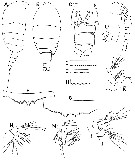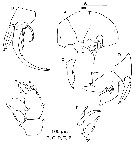|
|
 |
Fiche d'espèce de Copépode |
|
|
Calanoida ( Ordre ) |
|
|
|
Pseudocyclopoidea ( Superfamille ) |
|
|
|
Pseudocyclopidae ( Famille ) |
|
|
|
Pseudocyclops ( Genre ) |
|
|
| |
Pseudocyclops xiphophorus Wells, 1967 (F,M) | |
| | | | | | | Ref.: | | | Wells, 1967 (p.194, figs.F,M); Zagami & al., 2005 (p.68, Redescr.F,M, figs.F,M, Rem.); Brugnano & al., 2009 (p.347, figs.M, Rem.: sexual dimorphism); Chullasorn & al., 2010 (p.46, figs.M, Rem. M) |  issued from : C. Brugnano, G.A. Boxshall, G. Costanzo & G. Zagami in Scientia Marina, 2009. [p.350, Fig.3]. Male (Sexual dimorphism) (Lake Faro, NE Sicily): A, right exopod of P2 (specimen from Lake Faro, showing modifications to 2nd and 3rd exopodal segments and their outer spines; anterior view); B, P2 from specimen of Hong Kong with highly modified right exopod (anterior view; showing intrinsic musculature (endopodal muscles and endopodal setae omitted from right side); C, right exopod of P2 of paratype (anterior view showing unmodified outer margin spines and the presence of spinule rows on posterior surface (dotted) which indicates that isolated ramus is from right side; D, right exopod of P2 from Lake Faro, unmodified morphotype (anterior view).
|
 issued from : C. Brugnano, G.A. Boxshall, G. Costanzo & G. Zagami in Scientia Marina, 2009. [p.351, Table 1]. Swimming leg formula in the two morphotypes male.
|
 issued from : C. Brugnano, G.A. Boxshall, G. Costanzo & G. Zagami in Scientia Marina, 2009. [p.351, Fig.5]. SEM of anal somite and caudal rami (ventral view) showing modified spatulate caudal seta V on left side and slender unmodified seta on right side. Nota: In both morphotypes and in both sexes, the caudal ramus bears 6 setae, with seta II spiniform and flattened with a terminal flagellum; seta V is the longest and typically spatiulate or sword-shaped in form. Caudal seta V showed variation in shape in both sexes in the Lake Faro material. In this population some males and some females possessed a slender, unmodified caudal seta V, while others show the typical spatulate form (Zagami & al., 2005)
|
 issued from : J.B.J. Wells in Rrans. Roy. Soc. Edinburg, 1966/67, LXVII, 7. [p.195, Text-Fig.2]. Female (from North Bay: Inhaca Island, Mozambique): A-B, habitus (lateral and dorsal, respectively; C, urosome (ventral); D-G, posterior edge of urosomal segments; D-E, 2nd and 3rd segments; G, 4th segment (dorsal); F, 4th segment (ventral); I, A1; J, A2; K, Md; L, Md (cutting edge); M, Mx1; N, Mx2. Nota: head and 1st thoracic segment separate; 4th and 5 th segments fused. Relative proportions of metasome segments: 48 : 29 : 13 : 9 : 2 = 100. Cephalon with 3 eye spots. A1 17-segmented. P1-P4 with 3-segmented exopods and endopods. All segments without accessory ornamentation. P5 Posterior edge of urosomal segments with a hyaline frill, the distal edge denticulate; that of the 4th segment complex. Anal segment partially fused to the caudal rami. Caudal rami, each about as broad as long, proximal part of inner side expanded laterally on the dorsal side, these expansions partially overlapping each other. Apically with 5 setae and spines, the 3rd from the outer side a flattened, sword-shaped structure, the length of this seta is fairly constant (about 0.250 mm), the maximum breadth varying from 0.026 to 0.072 mm.
Male: H, posterior edge of 1st urosomal segment
|
 issued from : J.B.J. Wells in Rrans. Roy. Soc. Edinburg, 1966/67, LXVII, 7. [p.196, Text-Fig.3]. Female: A, caudal rami (dorsal); B, Mxp; P5. Nota: P5 exopd 3-segmented; endopod 2-segmented, 2nd segment with distal corners produced and with an apical seta.
Male: D, P5; E, A1. Nota: Left A1 as in female; right A1 modified. Urosome 5-segmented; relative proportions of segments: 26 : 16 : 20 : 18: 5 : 15 = 100. P5 highly modified.
|
 issued from : J.B.J. Wells in Rrans. Roy. Soc. Edinburg, 1966/67, LXVII, 7. [p.196]. Female: Relative proportions of segments of A1 (measured in the midlateral line).
|
 issued from : VJ.B.J. Wells in Rrans. Roy. Soc. Edinburg, 1966/67, LXVII, 7. [p.197]. Male: Armature of swimming legs, setal and spine formula.
|
 issued from : S. Chullasorn, F.D. Ferrari & H.-U. Dahms in Helgol. Mar. Res., 2010, 64; [p.49, Fig.12]. Male (from Wells' sample: BMNH1967. 8.4.2): A, protopod and endopods of P5 (anterior); B, right exopod of P5 (anterior); C, right exopod of P5, medial seta of proximal segment (posterior); D, left exopod (anterior). E, right P2 (middle segment and distal complex of exopod (anterior); F, lateral seta of middle segment and proximolateral seta of distal complex of exopod of P2 (lateral).
| | | | | Ref. compl.: | | | Giacomo & al., 2005 (p.98); Brugnano & al., 2006 (p.191, egg production rate); Zagami & al., 2008 (p.612, Rem.: egg production); Brugnano & al., 2009 (p.331, fecundity, development , survival vs temperature); Zenetos & al., 2010 (p.397); Pansera & al., 2014 (p.221, Table 2, abundance); Brugnano & al., 2014 (p.245, fecundity vs temperature); Belmonte, 2018 (p.273, Table I: Italian zones) | | | | NZ: | 3 | | |
|
Carte de distribution de Pseudocyclops xiphophorus par zones géographiques
|
| | | | | | | | | | | |  Issued from : C. Brugnano, A. Granata, L. Guglielmo, R. Minutomi & G. Zagami in Aquat. Biol., 2014, 20. [p.251, Fig.8 b]. Issued from : C. Brugnano, A. Granata, L. Guglielmo, R. Minutomi & G. Zagami in Aquat. Biol., 2014, 20. [p.251, Fig.8 b].
Relationships between temperature and mean egg production rates in (a) P. xiphophorus.
Symbols without error bars represent interpolated values from the regression line. |
| | | | Loc: | | | Mozambique (Inhaca Is.), W Medit. (NE Sicily: Lake Faro), Hong Kong | | | | N: | 9 | | | | Lg.: | | | (500) F: 0,759-0,719; M: 0,733-0,68; (984) F: 0,624-0,671; M: 0,624-0,656; (1057) F: 0,719-0,759; M: 0,680-0,733; {F: 0,63-0,76; M: 0,63-0,73} | | | | Rem.: | bentho-planktonic.
For Zagami & al. (2005, p.74) the Mediterranean specimens found in Lake Faro could represent a relict population of Tethyan origin.
For Wells (1966/67, p.197) P. magnus Esterly, 1911 and P. latens Gurney, 1927 have any resemblance to P. xiphophorus in the female P5. Both species are inadequately described in that the male is as yet unknown, [except magnus by Yeatman, 1975]. From the descriptions the only difference that can to exist between latens and magnus is in the presence or absence of spatulate setae at the points of insertion of the apical spines on the 3rd segment of the exopod of P5. Nicholls (1944) considers the species as synonyms contrary to Vervoort (1964, p.14) because the very incomplete knowledge of magnus. Comparing xiphophorus with magnus and latens, it differs from both in the presence of the suture (articulation line) between the segments bearing the maxillipede somite and the 1st pediger somite ; it is similar to magnus in the precise nature of the P5 and to latens in having a defree of overlap between the caudal rami, although in detail it is not as Gurney describes for latens. In conclusion, the author, cannot ascribe the Inhaca material to latens.
For Brugnano & al. (2014, p.252), the differences in seasonal and spatial abundance patterns between P. xiphophorus and P. umbraticus in Lake Faro (NE Sicily) might be due to differences in physiology and/or in predation pressure. The different sensivity of these species to temperature variation might be a further adaptation to their different substrate types (i.e the bottom of shallow shorelines, and fouling material suspended in the water colimn, respectively) and explain the species competition in the same locality. Indeed, P. umbraticus is more fecund at all temperature, but less reactive than P. xiphophorus to a temperature increment of as 6¨C. | | | Dernière mise à jour : 06/02/2020 | |
|
|
 Toute utilisation de ce site pour une publication sera mentionnée avec la référence suivante : Toute utilisation de ce site pour une publication sera mentionnée avec la référence suivante :
Razouls C., Desreumaux N., Kouwenberg J. et de Bovée F., 2005-2025. - Biodiversité des Copépodes planctoniques marins (morphologie, répartition géographique et données biologiques). Sorbonne Université, CNRS. Disponible sur http://copepodes.obs-banyuls.fr [Accédé le 03 décembre 2025] © copyright 2005-2025 Sorbonne Université, CNRS
|
|
 |
 |







